NZFFA Member Blogs
Member Blogs
-
Brian Cox's Blog
-
Chris Perley's Blog
-
Dean Satchell's blog
-
Denis Hocking's blog
-
Dennis Neilson's blog
-
Eric Cairn's Blog
-
Grant Hunters blog
-
Hamish Levack's Blog
-
Howard Moore's blog
-
Ian Brennon's blog
-
Ian Brown's Blog
-
Jeff Tombleson's blog
-
John Ellegard's blog
-
John Fairweather's blog
-
John Purey-Cust Ponders
-
Murray Grant's Blog
-
Nick Ledgard's Blog
-
Rik Deaton's Blog
-
Roger May's Blog
-
School of Forestry blog
-
Shem Kerr's blog
-
Vaughan Kearns blog
-
Wink Sutton's Blog
Recent blogs:
Steepland harvesting in Northland
Dean Satchell's blogTuesday, June 26, 2018
Innovation always interests me. Some innovations become lost to time while others become the next step in evolution and lead to greater things. Often they are just a minor tweak to the existing art, a fine tuning exercise, while sometimes they are grand, a big step change, a complete rethink that is revolutionary. What I enjoy the most when I see innovation in action is experiencing that eureka moment where I think "wow, I wish I'd thought of that"!
Innovators also interest me. Innovators search for the best way of doing things. For Peter Davies-Colley that search is not out of self-interest, but for the collective interest of the forest industry. He is thinking about how we can harvest better, and putting his ideas into practice. Someone needs to lead the way because harvesting is the bit we as an industry don't always do well. Doing better means less damage to the adjacent conservation areas, it means less damage to the soil and it means less sediment entering our waterways.
Peter has been commercially harvesting small blocks for farm foresters in Northland for more than a decade and has developed a good understanding of the problems we face. The solutions he has been developing are innovative and exciting. The thing about harvesting on steeplands is that not only should it be managed to cause as little environmental damage as possible, but somehow it also needs to be done cost-efficiently... and usually on a small scale to boot.
Then there is the distance these small blocks are from the nearest road. They were usually planted out the back of the farm on the steep stuff no good for anything else. Peter has modified a four-wheel-drive fertiliser spreader to be a log "forwarder" that is able to use existing farm tracks to shift the harvested logs from the back of beyond out to the makeshift landing beside the road. This means the investment in roading is significantly reduced for the landowner. Maintenance and erosion issues are also minimised by not having to make great big roads for great big log trucks.
This off road log truck has a gross vehicle mass (GVM) of 18 tonnes, unladen (TARE) weight of 7 tonnes and therefore a max payload of 11 tonnes. Peter generally loads it to a range of 8-10 tonnes. One of the key advantages with this truck over the heavier 6 and 8 wheeler forwarders is that it needs less area to turn, it goes around tighter corners and fits on smaller narrower roads.
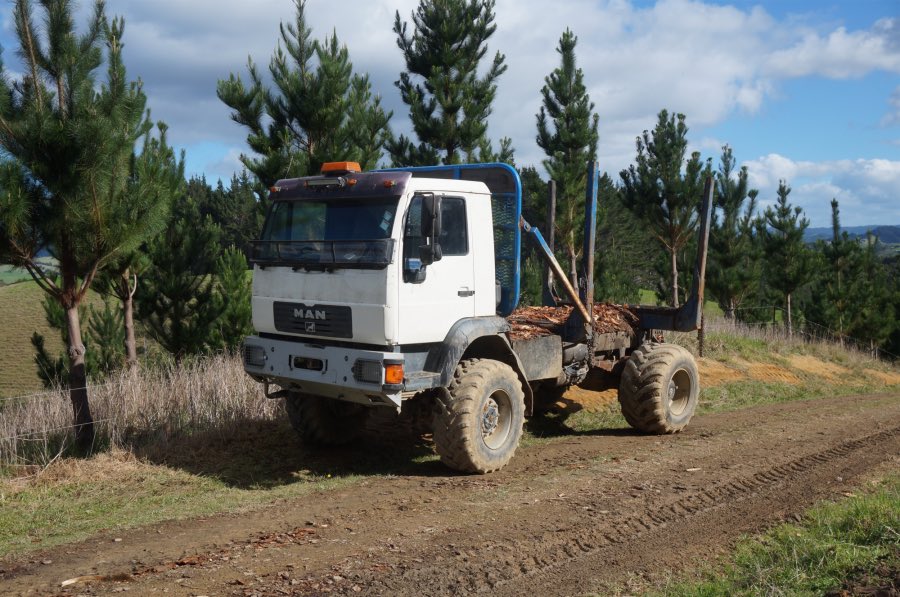
With a need for more off road log trucks in his own operation, Peter is building another two. They are easy to build now that he has developed the critical measurements.
Peters harvester started life as a 25 tonne machine, with a high and wide undercarriage. It now weighs in at 32 tonnes. The head is a Duxson felling head. Where this machine differs is that it has a winch mounted inside the body of the machine, capable of hauling 6 tonnes.
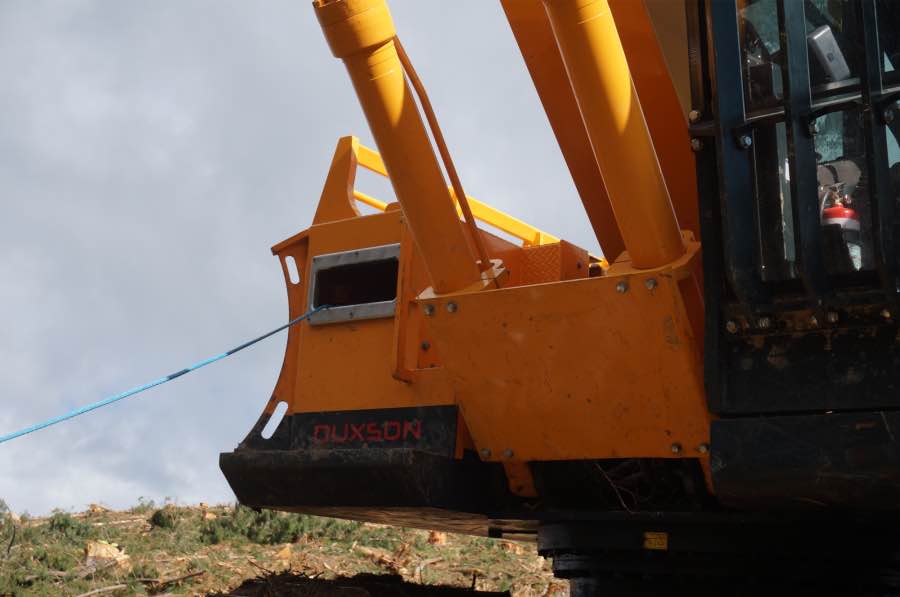
What is also interesting is that this winch uses a super-lightweight rope called dyneema, a 12 mm composite rope. This stuff is amazingly light and has a breaking strain of 17 tonnes.
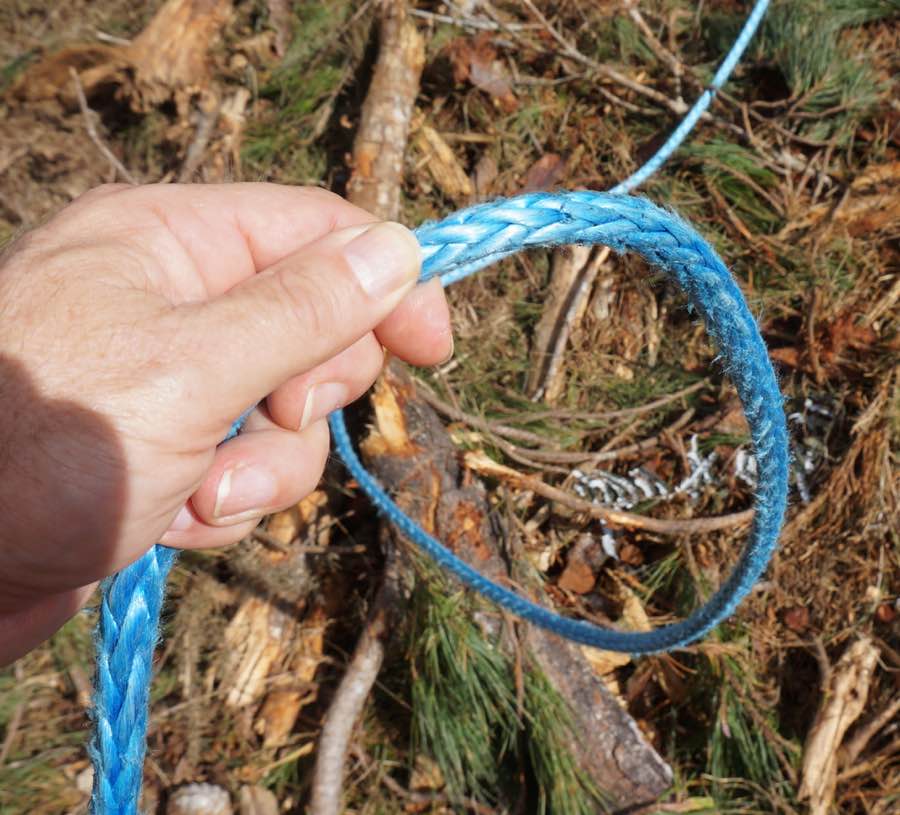
The winch rope is easily manhandled and even more easily repaired by splicing.
Most of the time this harvesting machine works as a standard feller buncher, harvesting trees and shovelling logs to the landing. But where the terrain gets too steep the machine walks down the slope as far as it can go. Trees below this are manually felled and then extracted with the winch, bunched and then shovelled up the one extraction track. A large area of trees can be extracted using one path, negating the need for cutting access tracks. Shovelling also causes much less soil damage than a skidder, because the logs are lifted and moved rather than dragged.
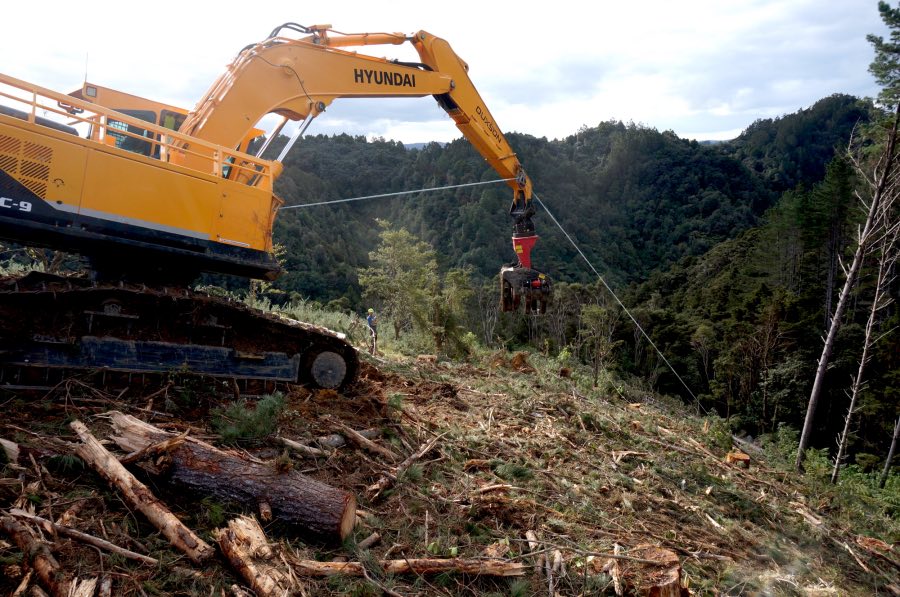
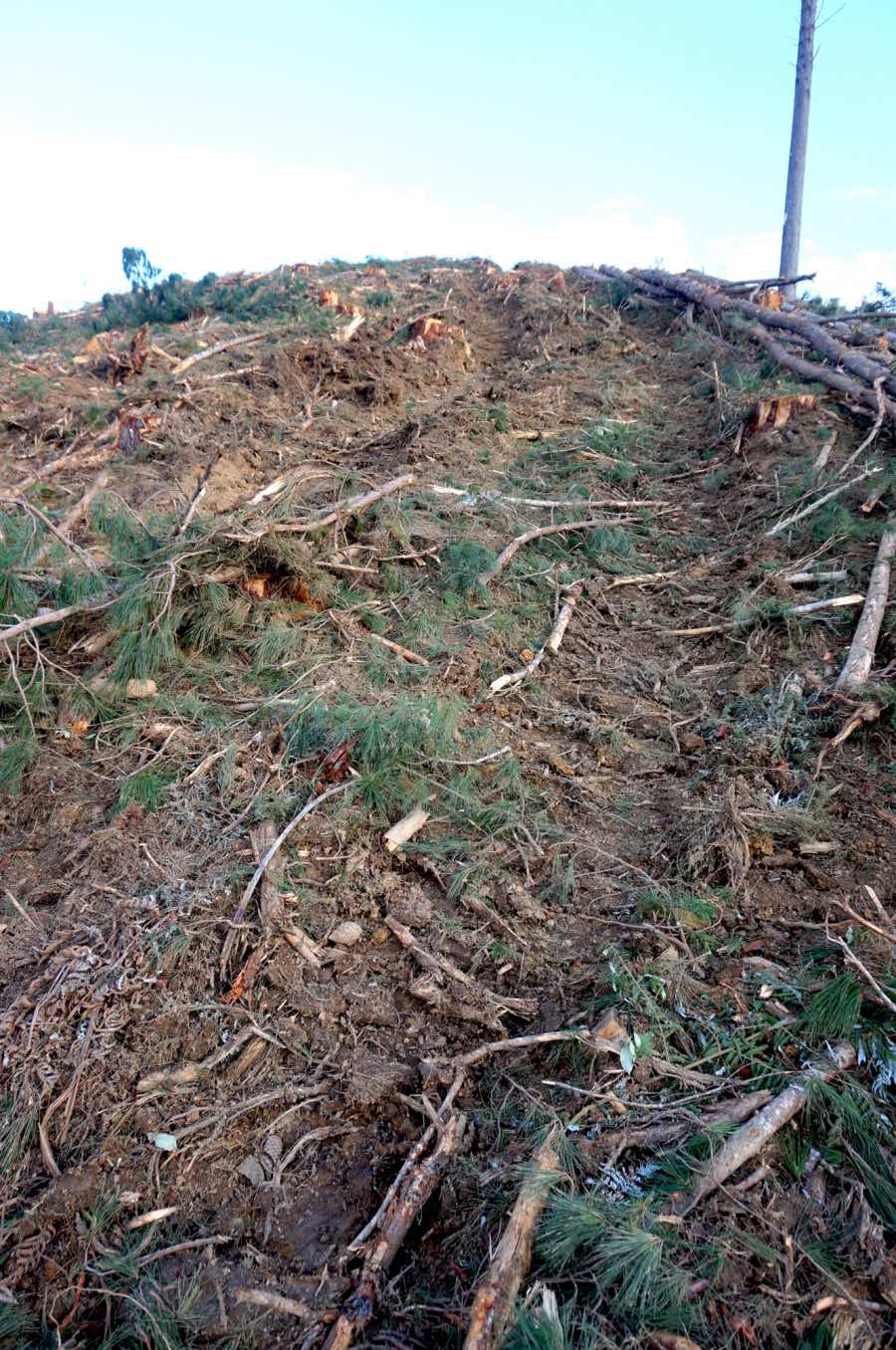
The winch is mostly used in small areas where the slope is too steep to get to with the machine. Productivity drops but Peter believes it is way more productive than other systems. The tradeoff seems to be about managing the right mix of equipment on each job for overall efficiency and with lowest environmental impact. In this case the stand adjoins an area of native bush with high environmental values, a QE2 open space covenant. The requirement was for no damage to the native bush, so the winch was used to directional fell these trees, then haul them up the slope to a central extraction path for shovelling to the track at the top of the slope.
Nice work Peter, looking forward to further developments!
Is there a case for timely pruning?
Wink Sutton's BlogTuesday, May 29, 2018
Two principles have emerged from a lifetime of plantation management research −
- That the size and the quality of trees at harvest are determined by the decisions at the time of planting such as site, species, genetics and spacing, and stand management in the first few years such as thinning and pruning.
- Log and tree returns at harvest are determined not by log and tree values at the time of early management decisions but by the price which exists on the day of harvest.
For sawlogs there are at least two decades between the time of early management decisions and that of the final harvest. To enhance the quality of the butt log, timely early pruning has been advocated, However, this increases management costs. Selective pruning − pruning only some of the final crop trees − is not feasible as on average, selected pruned trees tend to be soon overtaken by their unpruned neighbours.
In a recent article in the NZ Journal of Forestry, Tombleson quotes estimates that to compensate for the cost of pruning and the volume loss per hectare as a result of pruning, pruned logs at felling should command premiums of at least $80 a cubic metre. Current premiums for pruned logs are only about half this estimate.
For this reason, two of the largest plantation owners in the central North Island have generally decided not to prune. No other radiata growing country is effectively pruning on a large scale. Clear defect-free radiata is one of the best softwoods in the world, the equivalent of Ponderosa pine clears. The present competition for clearwood comes mostly from unsustainable old growth tropical trees. When harvested in 20 to 25 years time radiata pruned logs should be in considerable demand as there will be less international competition.
By concentrating simply on current log sale values, New Zealand could be seriously under-estimating the benefits of pruning. Certainly, the current premiums for pruned logs are lower than most growers or investors expected as well as being less than the compounded cost of pruning, but the downstream added value benefits are generally ignored.
Because of the possibility of pruned logs becoming sap-stained during sea transport, pruned logs are best processed in this country. Tombleson estimates that 12 plants in the central North Island process 1.226 million cubic metres of pruned logs a year, employ 1,575 staff and have an annual turnover of $734 million. These returns work out at $586 per cubic metre. This is an added value multiplier of more than three times the return that growers receive from supplying the domestic and export pruned log market, or over four times the returns for the best unpruned log exports.
I presume the central North Island forest owners have researched where future clearwood supplies will come from globally and have concluded that in the future, pruned logs could not command a $80 to $100 a cubic metre premium. The overseas forest owners appear to be most interested in reducing growing costs.They also appear to have little or no interest in downstream domestic processing.
Is there a case for timely pruning? Yes, there is.
Disclaimer: Personal views expressed in this blog are those of the writers and do not necessarily represent those of the NZ Farm Forestry Association.

 Farm Forestry New Zealand
Farm Forestry New Zealand
One post
Post from Rhod Lloyd on June 23, 2018 at 5:19PM
Add a post